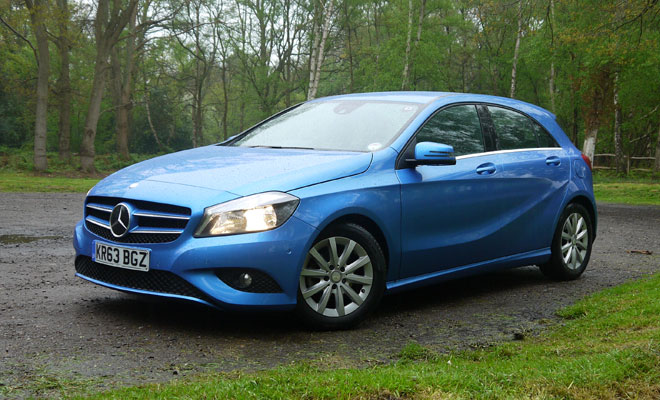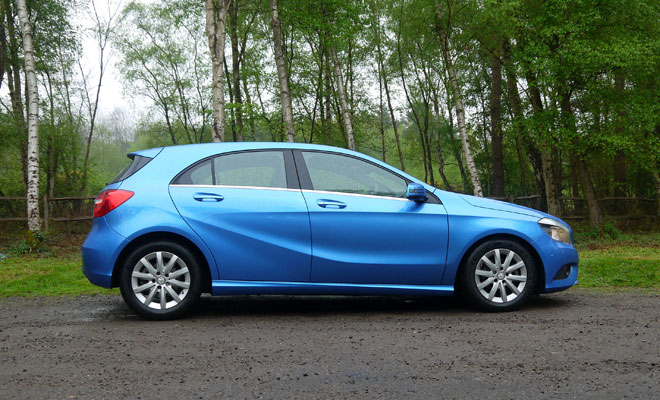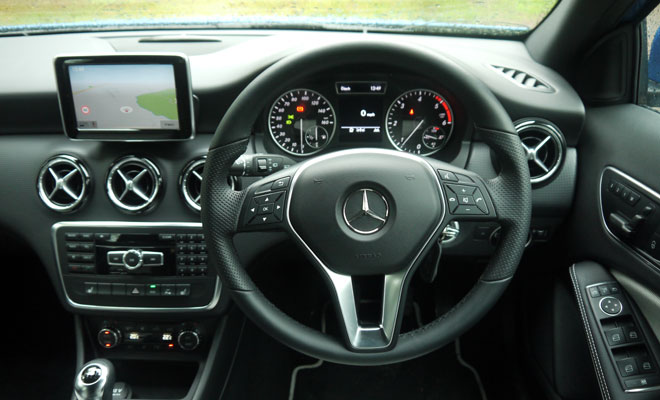by Lem Bingley 
So it’s a joy to get behind the wheel of the most frugal of A-Class editions and discover that it’s also the most forgiving. Though the suspension has been lowered in aid of superior aerodynamics – 10mm at the front and 15mm at the rear – the result is not so solid that it’ll scramble your wits or rattle your teeth.

Indeed the Eco-edition A-Class seems to offer a welcome balance between roadholding and comfort. The car may not be quite as composed through corners as BMW’s most frugal 1-Series, but it hangs onto the road doggedly enough and isn’t annoyingly jittery for the vast majority of the time when you’re not zipping through an S-bend.
Relatively tall 205/55 tyres on 16-inch alloys no doubt help to soften the ride, while the suspension drop helps these relatively modest wheels to fill the arches, avoiding the appearance of a car rolling on four shirt-buttons.

The A180 CDI Eco SE arrived in the UK in January this year, replacing the ordinary diesel A180 SE. The Eco label signifies a range of small tweaks employed to bring the official CO2 score down from 98g/km to 92g/km. That might not sound like a big step, but it’s giant leap for businesses buying company cars. New cars that creep below a 95g/km threshold qualify for valuable tax privileges that make them considerably easier on a company’s cashflow than those just a gram or two above.
As well as its lower suspension, the Eco edition has a more aerodynamic grille (apparently) and smooth underbody panels. The business of energy recuperation – using the alternator to charge the battery when slowing down – has also been made more effective in the Eco edition. Interestingly, there’s also a 40-litre fuel tank, 20% smaller than normal. I suppose this has the virtue of being about 9kg lighter when full, even if it does knobble range between fill-ups.
That said, the Eco A-Class ought to be able to go further per litre than other A-Classes, given that it has earned an official combined fuel consumption rating of 78.5mpg. No doubt that figure will require patience, skill and a strong tailwind to achieve in practice, though the example I borrowed did arrive showing 53.2mpg over the prior 300 miles, at the hands of drivers unknown. My efforts to pilot with an eye on consumption nudged 60mpg, though of course your own results may vary.

The car’s four-cylinder, 1.5-litre diesel engine provides a relatively modest 107bhp and 270Nm of torque. That’s enough to reach 62mph in 9.9 seconds, which means it can keep up with the cut and thrust when called upon. The car feels reassuringly gutsy during overtaking blasts, though it’s never the quietest companion. At least it’s fairly smooth and vibration free.
You do have to work the gears if you want to extract the full measure of get up and go, especially as they’ve been lengthened to keep the engine droning more lazily at cruising speeds. Fortunately the Eco car comes with a six-speed manual box that’s neat and precise if a little long in the throw. The clutch isn’t too heavy, provides decent biting-point feel, and as a bonus there’s enough space to rest your foot to one side when it’s not being kept busy.
With a fairly modest SE spec, it’s no surprise to find a few cutbacks in the Eco A-Class compared to more fancy trim levels. The instruments, for example, employ matt black plastic where plusher models offer a more classy brushed aluminium finish. The screen between the dials is also blocky and monochrome, where higher-ups enjoy high-res colour. There’s also no lid for the cubby by the gearstick, which seems like a penny-pinching omission. But given that the lid does tend to rattle, perhaps that’s no bad thing.

Even dressed down a little, the interior still looks attractive and feels well put together. You sit low at the front, with plenty of room for heads, legs and elbows. The rear seats are generous to knees but mean to the tops of heads, and light can feel in short supply at the back. The bulky front seats and narrow glazing do conspire to make riding in the rear feel like peering through a selection of letterboxes.
As with other A-Class models, the boot is on the small side, even for this class of car. At 341 litres it holds 19 litres less luggage than a 1-Series and 24 litres less than an Audi A3. A Volkswagen Golf, meanwhile, has them all beaten with 380 litres. And while we’re thinking of VWs, it’s worth considering that the BlueMotion Golf has the Eco A-Class beaten on virtually every measure excepting the presence of a large three-pointed star.
Prices for the A180 CDI Eco SE start at £21,965 – the cheapest A-Class in the range after the petrol-powered A180 SE. Metallic paint costs £570 extra, a digital stereo £420, and hands-free kit £360. A bunch of other bells and whistles including an internet-connected multimedia upgrade boosted the price of my test vehicle to £29,705 – which feels a little over the odds.
Stay in tune with the car and pick a more modest set of options, and the Eco A-Class is arguably the most appealing car in the range. It demonstrates that on occasion, less really can be more.


Mercedes A180 Eco
Rating: stars
Good: supple ride, frugal, not slow
Bad: not cheap, small tank, small boot
Price: from £21,965
The Mercedes A-Class has become a relatively common sight in the year or so since I first sampled the breed. Apparently more than 18,000 examples were sold in the UK during 2013 and I can only assume that profits are up among osteopaths. The AMG Sport editions in particular seem disinclined to make friends with your spine.Rating: stars
Good: supple ride, frugal, not slow
Bad: not cheap, small tank, small boot
Price: from £21,965
So it’s a joy to get behind the wheel of the most frugal of A-Class editions and discover that it’s also the most forgiving. Though the suspension has been lowered in aid of superior aerodynamics – 10mm at the front and 15mm at the rear – the result is not so solid that it’ll scramble your wits or rattle your teeth.

Indeed the Eco-edition A-Class seems to offer a welcome balance between roadholding and comfort. The car may not be quite as composed through corners as BMW’s most frugal 1-Series, but it hangs onto the road doggedly enough and isn’t annoyingly jittery for the vast majority of the time when you’re not zipping through an S-bend.
Relatively tall 205/55 tyres on 16-inch alloys no doubt help to soften the ride, while the suspension drop helps these relatively modest wheels to fill the arches, avoiding the appearance of a car rolling on four shirt-buttons.

The A180 CDI Eco SE arrived in the UK in January this year, replacing the ordinary diesel A180 SE. The Eco label signifies a range of small tweaks employed to bring the official CO2 score down from 98g/km to 92g/km. That might not sound like a big step, but it’s giant leap for businesses buying company cars. New cars that creep below a 95g/km threshold qualify for valuable tax privileges that make them considerably easier on a company’s cashflow than those just a gram or two above.
As well as its lower suspension, the Eco edition has a more aerodynamic grille (apparently) and smooth underbody panels. The business of energy recuperation – using the alternator to charge the battery when slowing down – has also been made more effective in the Eco edition. Interestingly, there’s also a 40-litre fuel tank, 20% smaller than normal. I suppose this has the virtue of being about 9kg lighter when full, even if it does knobble range between fill-ups.
That said, the Eco A-Class ought to be able to go further per litre than other A-Classes, given that it has earned an official combined fuel consumption rating of 78.5mpg. No doubt that figure will require patience, skill and a strong tailwind to achieve in practice, though the example I borrowed did arrive showing 53.2mpg over the prior 300 miles, at the hands of drivers unknown. My efforts to pilot with an eye on consumption nudged 60mpg, though of course your own results may vary.

The car’s four-cylinder, 1.5-litre diesel engine provides a relatively modest 107bhp and 270Nm of torque. That’s enough to reach 62mph in 9.9 seconds, which means it can keep up with the cut and thrust when called upon. The car feels reassuringly gutsy during overtaking blasts, though it’s never the quietest companion. At least it’s fairly smooth and vibration free.
You do have to work the gears if you want to extract the full measure of get up and go, especially as they’ve been lengthened to keep the engine droning more lazily at cruising speeds. Fortunately the Eco car comes with a six-speed manual box that’s neat and precise if a little long in the throw. The clutch isn’t too heavy, provides decent biting-point feel, and as a bonus there’s enough space to rest your foot to one side when it’s not being kept busy.
With a fairly modest SE spec, it’s no surprise to find a few cutbacks in the Eco A-Class compared to more fancy trim levels. The instruments, for example, employ matt black plastic where plusher models offer a more classy brushed aluminium finish. The screen between the dials is also blocky and monochrome, where higher-ups enjoy high-res colour. There’s also no lid for the cubby by the gearstick, which seems like a penny-pinching omission. But given that the lid does tend to rattle, perhaps that’s no bad thing.

Even dressed down a little, the interior still looks attractive and feels well put together. You sit low at the front, with plenty of room for heads, legs and elbows. The rear seats are generous to knees but mean to the tops of heads, and light can feel in short supply at the back. The bulky front seats and narrow glazing do conspire to make riding in the rear feel like peering through a selection of letterboxes.
As with other A-Class models, the boot is on the small side, even for this class of car. At 341 litres it holds 19 litres less luggage than a 1-Series and 24 litres less than an Audi A3. A Volkswagen Golf, meanwhile, has them all beaten with 380 litres. And while we’re thinking of VWs, it’s worth considering that the BlueMotion Golf has the Eco A-Class beaten on virtually every measure excepting the presence of a large three-pointed star.
Prices for the A180 CDI Eco SE start at £21,965 – the cheapest A-Class in the range after the petrol-powered A180 SE. Metallic paint costs £570 extra, a digital stereo £420, and hands-free kit £360. A bunch of other bells and whistles including an internet-connected multimedia upgrade boosted the price of my test vehicle to £29,705 – which feels a little over the odds.
Stay in tune with the car and pick a more modest set of options, and the Eco A-Class is arguably the most appealing car in the range. It demonstrates that on occasion, less really can be more.




